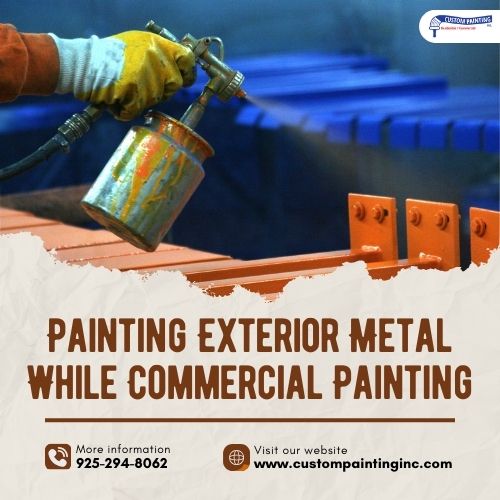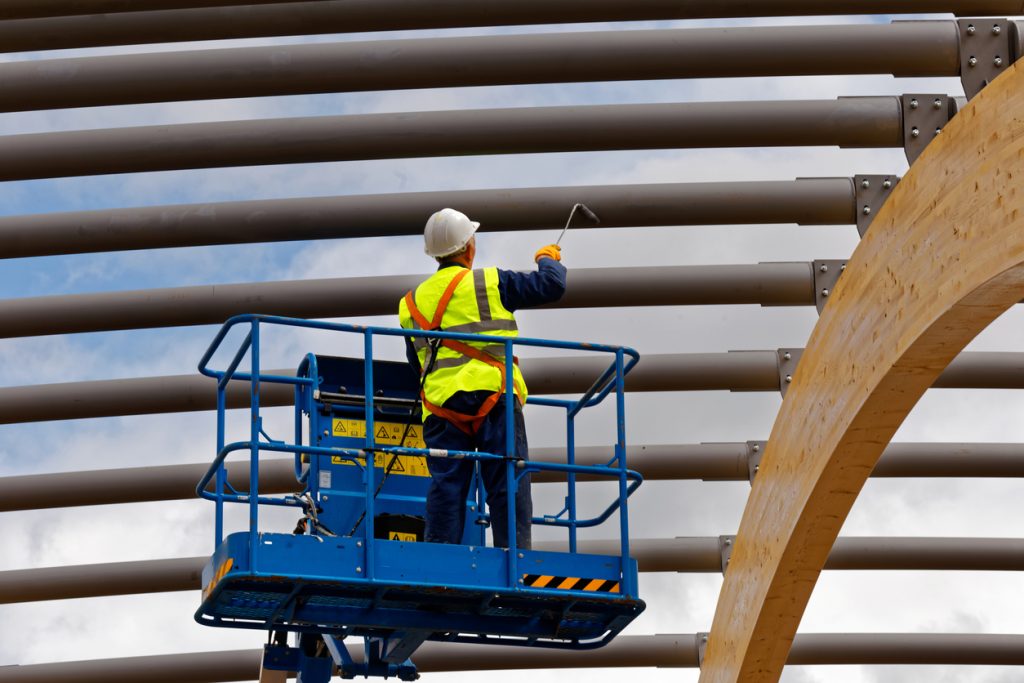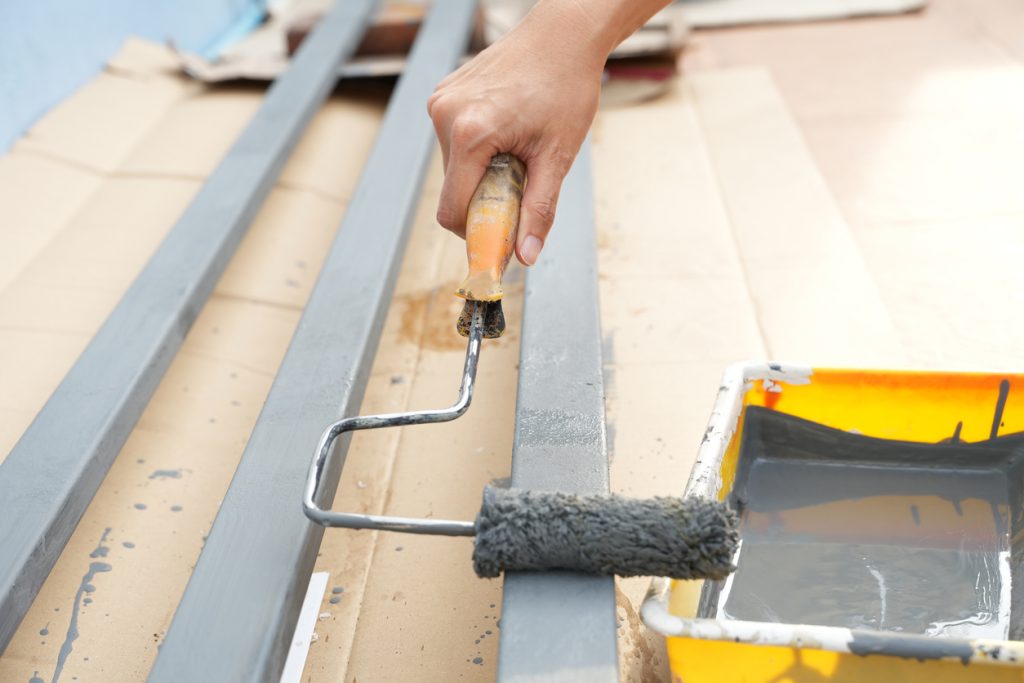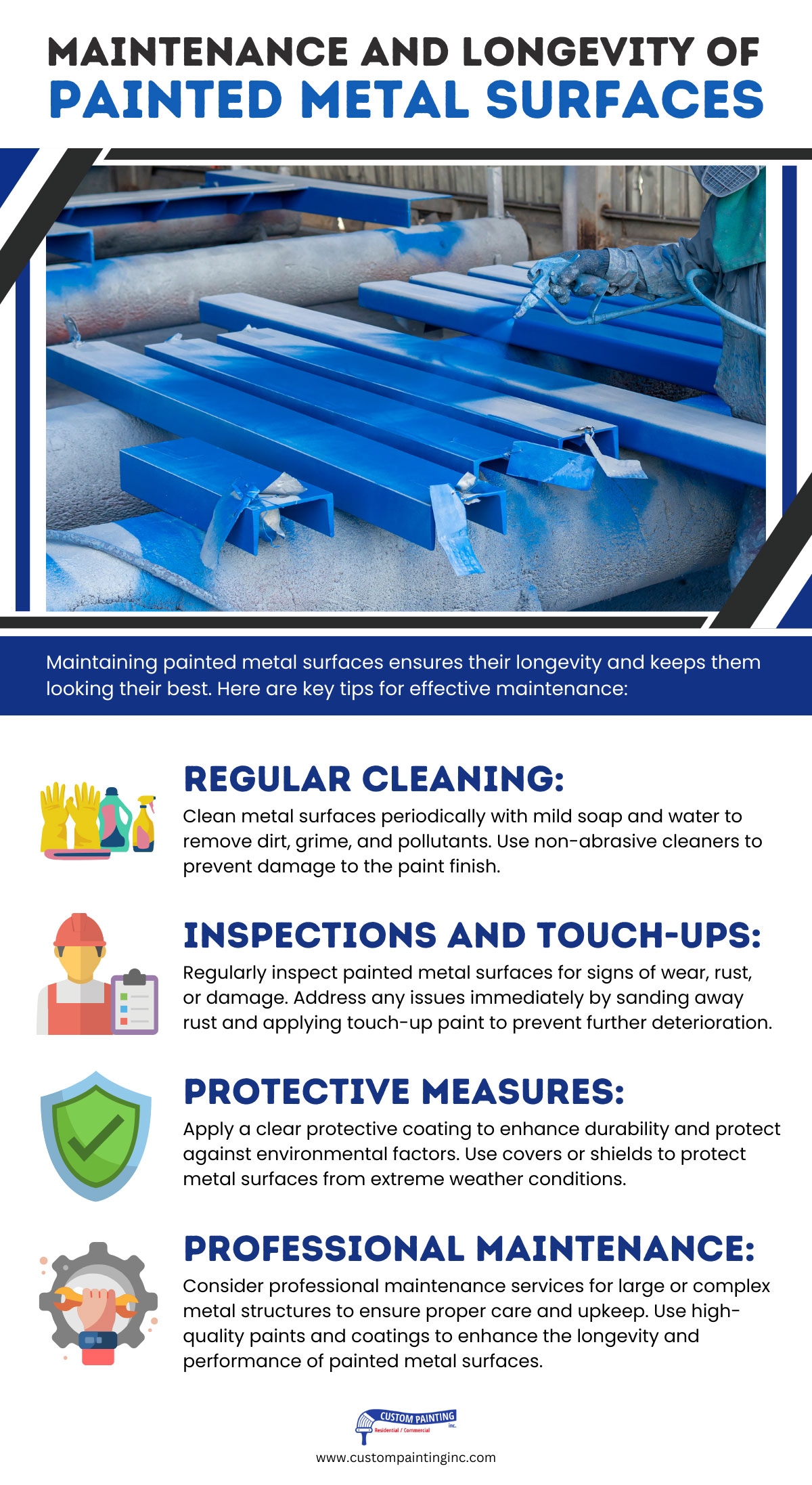Painting exterior metal surfaces during commercial painting projects requires careful planning and execution for Concord, CA area. Unlike other materials, metal demands specific preparation and coatings to ensure durability and a smooth finish. You may need to for example paint an existing rusty metal door. We will discuss the essential steps and tips for painting exterior metal, from choosing the right products to applying them effectively.
Whether you’re a professional painter or a business owner looking to enhance your property’s exterior, understanding these techniques will help you achieve a long-lasting and attractive result.
Importance of Painting Exterior Metal
Painting exterior metal surfaces in commercial settings goes beyond mere aesthetics. It plays a crucial role in enhancing the visual appeal of the property and providing long-lasting protection against various environmental factors.
Enhancing Aesthetic Appeal
A fresh coat of paint can dramatically transform the look of a Vallejo, CA commercial property. Metal surfaces, in particular, can lose their luster over time due to exposure to the elements. Repainting these surfaces revitalizes their appearance, making the entire building look more attractive and inviting. Fresh paint on metal features such as railings, doors, and awnings can create a polished and well-maintained look, which is crucial for businesses aiming to make a positive first impression.
1. Examples of How Well-Maintained Metal Exteriors Contribute to a Professional Image
- Storefronts: Painted metal frames and shutters can make storefronts look clean and modern, attracting more customers.
- Office Buildings: Repainting metal fixtures and exterior elements can give an office building a sleek, professional appearance that instills confidence in clients and partners.
- Industrial Facilities: Well-maintained metal structures in industrial settings can enhance the overall image of the business, reflecting a commitment to quality and attention to detail.
Providing Protection and Durability
One of the primary reasons for painting metal surfaces is to protect them from rust and corrosion. Metal is highly susceptible to these issues, especially when exposed to moisture, salt, and other corrosive substances. A high-quality paint job acts as a barrier, preventing moisture and other elements from coming into direct contact with the metal. This protective layer helps extend the life of the metal, reducing the need for costly repairs or replacements.
1. Long-Term Benefits of Maintaining Painted Metal Surfaces for Structural Integrity
- Prevention of Rust and Corrosion: Regularly painting metal surfaces can prevent rust and corrosion, which can weaken the metal over time.
- Increased Longevity: By protecting metal surfaces, painting helps maintain the structural integrity of the property, ensuring that metal components last longer and perform better.
- Cost Savings: Maintaining painted metal surfaces reduces the frequency of repairs and replacements, saving money in the long run.
- Safety: Properly maintained metal surfaces are less likely to fail, which enhances the overall safety of the building and its occupants.
Painting exterior metal surfaces is essential for both aesthetic and functional reasons. It not only improves the appearance of a commercial property but also provides critical protection against environmental damage, ensuring longevity and structural integrity.
Preparing Metal Surfaces for Painting
Proper preparation of metal surfaces is essential to achieve a durable and long-lasting paint job for Pleasant Hill, CA area businesses. This section outlines the key steps involved in preparing metal surfaces for painting, including cleaning and degreasing, removing rust and old paint, and priming the surface.
Cleaning and Degreasing
Before starting any Antioch, CA area painting project, it is important to ensure that the surface is clean and free of contaminants. Dirt, grease, and other residues can prevent paint from adhering properly, leading to peeling and flaking over time. Cleaning and degreasing the metal surface ensures that the paint bonds effectively, resulting in a smooth and durable finish.
1. Techniques for Thorough Cleaning and Degreasing of Metal Surfaces
- Soap and Water: For lightly soiled surfaces, a mixture of soap and water can effectively remove dirt and grime. Use a scrub brush to thoroughly clean the surface, and rinse with clean water.
- Solvent Cleaners: For tougher grease and oil residues, solvent-based cleaners such as acetone or mineral spirits can be used. Apply the solvent with a clean cloth and wipe the surface until it is clean.
- Degreasers: Commercial degreasers are specifically formulated to break down and remove heavy grease and oil. Follow the manufacturer’s instructions for application and rinsing.
Removing Rust and Old Paint
Here are some of the methods to remove rust:
- Wire Brushing: Use a wire brush to scrub away loose rust. This method is effective for surface rust and small areas.
- Sanding: Sandpaper or a sanding machine can be used to remove rust and smooth the surface. Start with coarse grit sandpaper and gradually move to finer grit for a smoother finish.
- Chemical Rust Removers: These products chemically dissolve rust, making it easy to wipe away. Follow the instructions carefully and ensure proper ventilation when using chemical rust removers.
1. Techniques for Stripping Old Paint to Achieve a Smooth Surface
- Scraping: Use a paint scraper to remove loose or peeling paint. This is a basic but effective method for small areas.
- Sanding: Sanding can also be used to remove old paint, especially when combined with rust removal. An electric sander can speed up the process for larger surfaces.
- Chemical Paint Strippers: These products soften the old paint, making it easy to scrape off. When using chemical strippers, be sure to wear protective gear and work in a well-ventilated area.
Priming the Surface
Primer is essential for creating a strong bond between the metal surface and the topcoat of paint. It helps prevent rust and corrosion and provides a smooth, even surface for the paint to adhere to. Using the correct primer ensures that the paint job will last longer and resist wear and tear.
1. Types of Primers Suitable for Different Metal Substrates and Environmental Conditions
- Epoxy Primers: These are highly durable and offer excellent adhesion to metal surfaces. They are ideal for harsh environments where the metal is exposed to moisture and chemicals.
- Zinc-Rich Primers: These primers contain high levels of zinc and provide exceptional corrosion resistance. They are commonly used on steel and iron surfaces.
- Acrylic Primers: These water-based primers are suitable for less extreme conditions. They offer good adhesion and rust resistance and are easy to apply and clean up.
- Rust-Inhibitive Primers: Formulated to prevent rust from forming, these primers are ideal for use on surfaces that are prone to rust.
By following these steps and using the appropriate products, you can ensure that your metal surfaces are properly prepared for painting. This preparation is crucial for achieving a high-quality, durable finish that enhances both the appearance and longevity of your commercial property.
Choosing the Right Paint for Metal
Selecting the appropriate paint for metal surfaces is critical to achieving a durable and aesthetically pleasing finish. The right paint will protect the metal from environmental damage while enhancing its appearance.
Types of Paint Suitable for Metal
- Oil-based Paints
- Durability: Oil-based paints offer excellent durability and resistance to wear and tear, making them suitable for high-traffic areas and exterior surfaces.
- Finish: They provide a smooth, glossy finish that enhances the look of metal surfaces.
- Application: Oil-based paints take longer to dry and require solvents for cleanup, but their long-lasting finish makes them a popular choice for many commercial applications.
- Acrylic Paints
- Versatility: Acrylic paints are water-based and can be used on a variety of metal surfaces. They are easy to apply and clean up with water.
- Quick Drying: These paints dry faster than oil-based options, reducing downtime during painting projects.
- Finish: Acrylic paints offer a range of finishes, from matte to high gloss, providing flexibility in achieving the desired look.
- Enamel Paints
- Hard Finish: Enamel paints dry to a hard, durable finish that resists scratches and impacts.
- Weather Resistance: They are highly resistant to weathering, making them ideal for exterior metal surfaces exposed to the elements.
- Application: Enamel paints can be oil-based or water-based, offering various application options depending on the specific needs of the project.
Environmental Considerations
- UV Resistance: Choose paints with UV-resistant properties to prevent fading and deterioration from sun exposure, especially for outdoor metal surfaces.
- Moisture Resistance: For metal surfaces exposed to rain or humidity, select paints with excellent moisture resistance to prevent rust and corrosion.
- Thermal Expansion: Metal expands and contracts with temperature changes. Select flexible paints that can accommodate these movements without cracking or peeling.
- Heat Resistance: For surfaces exposed to high temperatures, such as metal roofs or industrial equipment, use heat-resistant paints designed to withstand extreme heat without degrading.
Compatibility with Primers
- Chemical Compatibility: Ensure that the chosen paint is compatible with the primer used on the metal surface. Using incompatible products can lead to adhesion issues and reduce the lifespan of the paint job.
- System Approach: Some manufacturers offer paint and primer systems designed to work together, providing optimal adhesion, durability, and protection.
Choosing the right paint for metal surfaces involves considering the type of paint, environmental factors, application methods, and compatibility with primers. By selecting the appropriate products and techniques, you can achieve a long-lasting, attractive finish that enhances and protects your metal surfaces.
Application Techniques for Metal Surfaces
Applying paint to metal surfaces requires specific techniques to ensure a smooth, durable, and professional finish. The choice of technique can significantly impact the quality and longevity of the paint job. This section will cover various application techniques, including preparation, methods, and post-application care.
- Surface Preparation: Cleaning is crucial for removing dirt, grease, and other contaminants that can prevent paint from adhering properly. Use soap and water for light cleaning, solvent cleaners for grease removal, and commercial degreasers for heavy contaminants. Ensure the surface is completely dry before proceeding.
- Sanding and Rust Removal: Sanding smooths out rough areas and removes rust, creating a uniform surface for painting. Use sandpaper, wire brushes, or power sanders to achieve the desired smoothness. Chemical rust removers can be effective for rust removal.
- Priming: Primer provides a base layer that improves paint adhesion and protects the metal from corrosion. Apply the primer evenly, allowing it to dry completely according to the manufacturer’s instructions before painting.
Painting Methods
- Brush and Roller Application: Brushes and rollers are ideal for smaller surfaces and detailed work, offering precise control. Use high-quality brushes and rollers designed for metal paints. Apply thin, even coats, allowing each coat to dry before applying the next.
- Spray Painting: Spray painting is fast and efficient, especially for large or irregular surfaces. Use a sprayer suitable for the type of paint being used. Maintain a consistent distance from the surface and apply thin, even coats. Overlapping passes help ensure complete coverage.
- Dipping: Dipping is used in industrial settings for small parts and components. Submerge the metal piece into a vat of paint, ensuring complete coverage. Remove and allow excess paint to drip off before drying.
Post-Application Care
- Drying Time: Allow sufficient drying time between coats and after the final coat to ensure a durable finish. Follow the paint manufacturer’s recommendations for drying times. Environmental conditions such as temperature and humidity can affect drying times.
- Inspection and Touch-Ups: After the final coat is dry, inspect the surface for any imperfections or missed areas. Use a brush or sprayer to touch up any areas that need additional coverage. Ensure that touch-ups blend seamlessly with the rest of the paint job.
- Protective Coatings: For extra durability, consider applying a clear protective coating over the paint. Use clear acrylic or polyurethane coatings that are compatible with the paint used. These coatings can enhance the appearance and provide added protection against scratches and environmental damage.
Environmental Factors
Environmental conditions can affect the application and drying process of the paint. Aim for moderate temperatures and low humidity to achieve the best results. Avoid painting in extreme heat, cold, or high humidity.
Using the right application techniques for metal surfaces is essential for achieving a high-quality, durable finish. By properly preparing the surface, choosing the appropriate painting method, and following post-application care guidelines, you can ensure that your metal surfaces look great and stand the test of time.
Safety and Compliance Considerations
Ensuring safety and compliance during metal painting projects is crucial for protecting workers and adhering to regulations. Here are key points to keep in mind:
- Personal Protective Equipment (PPE): Use gloves, safety goggles, masks, and protective clothing to guard against fumes, splashes, and dust. Wear masks or respirators when working with solvent-based paints or in poorly ventilated areas to avoid inhaling harmful fumes.
- Ventilation: Ensure proper ventilation in the workspace to disperse fumes and reduce the risk of inhalation. Implement exhaust fans or work in open areas to maintain a safe air quality level.
- Handling and Storage: Follow manufacturer guidelines for handling paints, primers, and chemicals to prevent accidents and spills. Store materials in a cool, dry place away from heat sources and direct sunlight. Ensure that containers are tightly sealed.
- Compliance with Regulations: Adhere to local and federal safety regulations, including OSHA standards, for workplace safety and environmental protection. Dispose of paint cans, solvents, and other waste materials according to local hazardous waste disposal regulations to minimize environmental impact.
- Fire Safety: Recognize that many paints and solvents are flammable. Keep them away from open flames and heat sources. Have fire extinguishers readily available in the work area and ensure workers are trained in their use.
By prioritizing safety and compliance, you can create a safer work environment and ensure that your painting project meets all necessary regulations.
Maintenance and Longevity of Painted Metal Surfaces
Maintaining painted metal surfaces ensures their longevity and keeps them looking their best. Here are key tips for effective maintenance:
- Regular Cleaning: Clean metal surfaces periodically with mild soap and water to remove dirt, grime, and pollutants. Use non-abrasive cleaners to prevent damage to the paint finish.
- Inspections and Touch-Ups: Regularly inspect painted metal surfaces for signs of wear, rust, or damage. Address any issues immediately by sanding away rust and applying touch-up paint to prevent further deterioration.
- Protective Measures: Apply a clear protective coating to enhance durability and protect against environmental factors. Use covers or shields to protect metal surfaces from extreme weather conditions.
- Professional Maintenance: Consider professional maintenance services for large or complex metal structures to ensure proper care and upkeep. Use high-quality paints and coatings to enhance the longevity and performance of painted metal surfaces.
By following these maintenance practices, you can extend the lifespan of painted metal surfaces and keep them in excellent condition.
Conclusion
Proper painting and maintenance of exterior metal surfaces can enhance the appearance, protection, and longevity of your commercial property. By following the outlined steps and techniques, you can achieve a durable and attractive finish. For professional assistance, contact Custom Painting, Inc. at 925-686-0903 or fill out our contact form.






